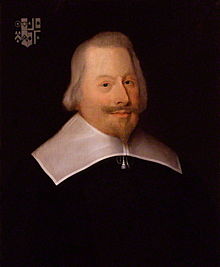
Back Джон Пім Byelorussian John Pym Welsh John Pym German John Pym Spanish John Pym Finnish John Pym French John Pym Italian ジョン・ピム Japanese John Pym Polish Пим, Джон Russian
John Pym | |
|---|---|
 John Pym, c. 1640 | |
| Committee of Safety | |
| In office July 1642 – December 1643 | |
| Monarch | Charles I |
| Member of Parliament for Tavistock 1624; 1625; 1626; 1628; 1640 | |
| In office November 1640 – December 1643 † | |
| Member of Parliament for Calne | |
| In office 1621–1622 | |
| Receiver-General Exchequer, Glos., Hants and Wilts. | |
| In office 1606–1639 | |
| Personal details | |
| Born | 20 May 1584 London, England |
| Died | 8 December 1643 (aged 59) London, England |
| Cause of death | Cancer |
| Resting place | Westminster Abbey (initially); St Margaret's (now) |
| Spouse | Anne Hooker or Hooke (1604–1620) |
| Children | 7, including Charles |
| Parent(s) | Alexander Pym (1547–1585) Philippa Colles |
| Relatives | Francis Rous (stepbrother) Anthony Nicholl (nephew) |
| Alma mater | Pembroke College, Oxford |
| Occupation | Lawyer, politician and businessman |
John Pym (20 May 1584 – 8 December 1643) was a politician and administrator from London, who played a major role in establishing what would become the modern English Parliamentary system. One of the Five Members whose attempted arrest in January 1642 was a major step in sparking the First English Civil War, his use of procedure to out manoeuvre opponents was unusual for the period. Though this meant he was respected by contemporaries rather than admired, in 1895 historian Goldwin Smith described him as "the greatest member of Parliament that ever lived".[1]
Pym's father died when he was seven months old, and he was raised by his stepfather Sir Anthony Rous, from whom he inherited his Puritan views and deep opposition to the reforms of Archbishop William Laud. He was also a leading member of the Providence Island Company, which attempted to establish a Puritan colony in Central America.
Described as 'a true revolutionary', he led the opposition to arbitrary rule first under James I, then Charles I. His leadership in the early stages of the war was essential to the Parliamentarian cause, particularly his role in negotiating the Solemn League and Covenant with the Scots Covenanters; his death from cancer in December 1643 was considered a major blow.[2]
Originally buried in Westminster Abbey,[3] after the Stuart Restoration in 1660, his body was dumped in a pit at nearby St Margaret's, Westminster along with those of other Parliamentary leaders.[4] Though his reputation later suffered in comparison to less complex figures like John Hampden and Viscount Falkland, he is now viewed as an astute politician and effective speaker. Many of his ideas were adopted by Patriots during the American Revolution and 19th-century American liberals.[5]
- ^ MacDonald 1969, p. 38.
- ^ Royle 2004, p. 278.
- ^ Stanley, A.P., Historical Memorials of Westminster Abbey (London; John Murray; 1882), p. 204.
- ^ Stanley 1882, pp. 204–205.
- ^ Kuypers & Althouse 2009, pp. 225–245.
© MMXXIII Rich X Search. We shall prevail. All rights reserved. Rich X Search